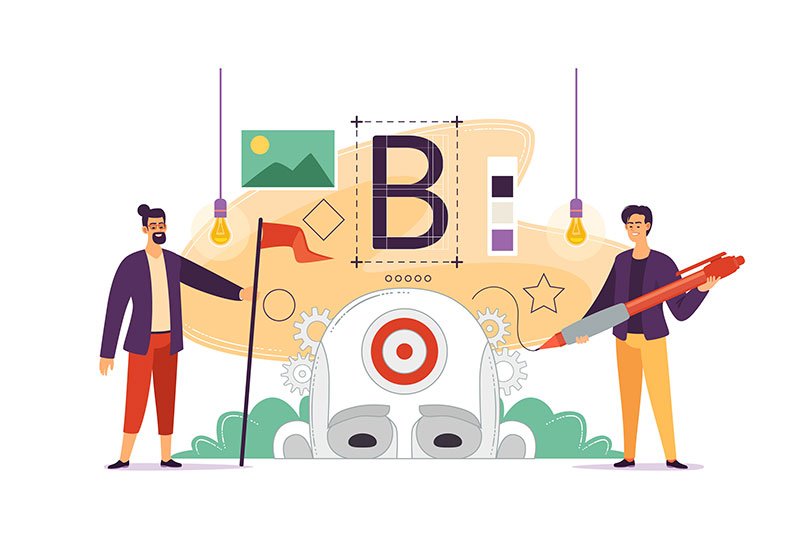Step by step to build a brand for your business
Building a brand from scratch is no easy task. And we’re not even talking about the disclosure and recognition process, but about the definition of the name, logo, colors and so on.
If you’re starting your online business and you need your audience to easily recognize and remember you, you need to build a brand.

What is a brand?
Much more than a logo and a name, your brand is like the people notice and remember your business.
Everyone recognizes the Nike brand, the name doesn’t even have to be written, and it is automatically associated with sports and dynamism.
So do several others, like Apple’s bitten apple and McDonald’s stylized M.
But building a brand is not just for big or small companies, people also have personal brands.
In the same way that a company is associated with images and colors that convey a message, each of us has a name, a face, a style and a way to communicate. With these characteristics, we pass impressions and transmit our own messages, consciously or not.
To build a brand, you must think about it, and do everything consciously. Think exactly what is the message you want to convey, because that’s what will attract people to your business.
How to build a brand
To build a brand you must follow five basic steps:
1. Research your target audience and competitors
Before making any decision about creating a commercial brand, you need to understand the market you are in, that is, who your competitors and potential customers are.
There are several ways to do this, such as:
- Search Google for your product or service and analyze the competitors that appear.
- Talk to people in your target market and ask which brands they buy.
- Look at the social media pages your target audience follows.
As you observe how your competition presents and acts, also observe how your target audience manifests itself.
Pay attention to their profile, the language they use, what they are interested in, what attracts them.
Having this very clear will give you the first north to build a successful brand.
– How to find out what my audience wants and attract leads
2. Determine your personality
Here is the biggest brainstorming part of the whole process.
Based on your target audience, since your brand cannot focus on pleasing everyone, think about some questions:
Market positioning
Positioning is nothing more than one or two lines in which you define in which market you operate.
Your positioning statement should look something like:
We offer [PRODUCT/SERVICE] to [TARGET MARKET] at [VALUE PROPOSITION], with the following [KEY DIFFERENTIATOR].
For example: I offer an online math course for beginners. As a differential, you leave ready to make calculations and build spreadsheets in excel for the job market.
Your value proposition is the most important thing. Find it, explore it, and make it part of your brand message.
Words and concepts that represent you
One way to build a brand is to imagine it as a person. How would she be? What kind of personality would she have?
Here comes a big brainstorming exercise. Take a blank sheet of paper and start writing down all the words and concepts that come to mind related to that person.
Focus on adjectives, listing characteristics and qualities she has. Then write down what she would like to have or what she would match with, such as type of car, animal, celebrity, food, and so on.
This will help you create shapes, as well as set a tone of voice for your brand.
3. Choose your brand name
Depending on the type of business you want to start, such as selling online courses, for example, perhaps the name matters very little, or is not even necessary.
If you are selling an info product, the name could be the product itself, such as “Beginner to Advanced Patchwork Courses”.
– 7 types of infoproducts to sell online
But if you’re starting a company with a wider range of products or services, you’ll probably need to bring that together under one name.
If so, think about it, because it will affect your brand logo, your domain, your marketing and your trademark registration.
If you plan to expand the product lines you offer in the future, consider keeping your company name broad for easy rotation.
Defining a name for your company when building a brand can be a very complex task, and there are professionals who work just with that, doing research based on your target audience and market positioning to generate ideas and concepts.
But if you are going to do it yourself, some approaches are:
- Just make up a word that sounds good to you, like Pepsi.
- Find a word or concept you like and see how it is spelled in other languages.
- Use a suggestive word or metaphor, like Buffer.
- Play around with the initials of your first and last name and see if something you like comes up, as in the case of Adidas ( Adolf “Adi” Dassler) and M&M’s (initials of the surnames of its founders: Forrest Marte and William Murrie).
- Change a word by removing letters or adding letters like Speedo or Activia.
- Create an acronym from a longer name, such as FIAT (Fabbrica Italiana Automobili Torino) e IBM (International Business Machines).
- Combine two words or try abbreviations, like LEGO (abbreviation of the words Leg Godt, which means “play well” in Danish).
As your brand name will also affect your website domain/URL, be sure to search to see what’s available.
And don’t forget about SEO. It is certainly easier to index your site better if your company name has to do with what you sell. Although we recognize that this is often impossible.
If you like some options, consult people close to you to see what they think. Sometimes a fresh look is all you need to find the perfect name.
– How to use SEO for brand awareness
4. Define your brand’s visual identity
After defining a name, you will need to think about your visual identity, that is, all the colors, fonts and other elements that will represent your brand.
This is essential when you build your website, for example, or create posts for your social networks. Having a standard passes professionalism.
Choose your colors
When building a brand, colors are very important because they not only define a look but also convey the feeling you want to communicate.
Fast food brands often use warm colors that convey excitement and desire, such as red and yellow.
Tech companies usually opt for neutral colors like black and white, which convey sophistication and power.
See the table below to get a better idea of the color psychology which, despite not being an exact science, helps a lot when defining which palette to use in your business.

When you begin to build a brand you are unlikely to use just one color, so always keep legibility in mind and what colors work well together.
If you don’t understand anything about the subject, hire help from a professional or use software that will help you solve this combination.
Choose your fonts
The best way to build a brand when it comes to fonts is to keep it simple.
Choose at most two fonts to avoid confusing visitors: one for titles and one for body text.
Some sites offer free fonts, such as:
Choose sources that share some criteria, such as overall proportions (height and width), structure, and skeleton.
Even if the resemblance is subtle, it helps to give coherence to your visual identity.
Design a logo
Logotype is a word composed of two terms of Greek origin: “logos”, which means concept or word, and “typos”, which is translated as figure or symbol. Thus, we can say that the logo is a drawing representing a brand.
As we mentioned the name earlier, not every business will need a logo.
Rarely those who sell infoproducts, such as online courses or ebooks, have one.
But if you’re looking to build a brand for your business, an easy-to-recognize logo can be essential.
A logo needs to be easy to apply and quick to understand, since it is made to appear in the most diverse media, such as websites, social media posts, packaging, printed materials and so on.
So create something that works for all sizes and can be applied to backgrounds with different colors (at least one light and one dark version).
Get inspired by logos that pop easily into your head and that you would recognize even if you couldn’t understand anything else written around them (when you see a stylized dove, you would still know it was a Dove product, even if you were in China).
– Find out how much you can profit from selling online courses
5. Brand your entire business
The whole purpose of building a brand is to create a strong identity for your business, an image that your audience can quickly associate with you. So once you create one, start applying it to everything that belongs to your business.
Now that you already have a visual identity, it’s time to give your brand content, writing its mission, values and a bit of its history.
A Shopify survey on what earns customer trust revealed that people who buy from an online store for the first time often look for its mission and purpose to see if they share some value with the company (like sustainability).
If you’re a new business, it’s common for people to also search your “about us” page to learn more about who they’re buying from, as this builds more confidence.
Don’t be shy if you have little to say, the story of any brand evolves over time. In the meantime, focus on making clear your values as a company and what you have to offer of value to your customers.
Create a professional website, with a solid visual identity and coherent content, and your business will start to grow consistently.
– How much does it cost to build a website for my business?
Build a brand and grow your business

It’s important to realize that you will never have 100% control over how people perceive your brand identity.
You can point customers in the right direction, make a great first impression, and manage your reputation, but it can’t control the individual perceptions that exist in each person’s mind.
All you can do is do your best every step and try to resonate with your core audience.
If you are starting a business selling online courses, Coursify.me is here to make your life a lot easier.
Learning Management System (LMS), our platform allows you to create a completely customizable page for your school, choosing your colors, images, logo and much more.
– Whats is a Learning Management System
Complete eLearning platform, Coursify.me is the ideal solution for those who want to create, sell and promote courses on the internet.
Serving companies and professionals in more than 60 countries, the platform offers several customization options so you can create a virtual school with your “face”.
Visit our site, test the platform and give the first step to build a brand for your online business.

